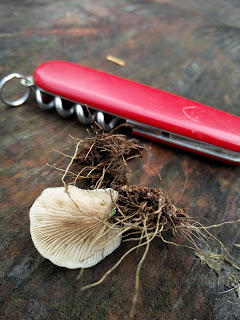I heard back from Malcolm Knight, Chair of the
Tottington Woodlanders, last week - confirming that they'd be delighted for me to survey the woodland fungi and granting me permission to venture off the public rights of way, within the boundary of the Local Nature Reserve - as long as I tread carefully. Woohoo!
So I took advantage of another damp grey day yesterday to explore a couple of the coppice compartments a little further, and see what I could see.
First up, I found some blobby-looking white crust fungus growing on the
underside of a fallen (birch?) branch. Intensive study of my reference
books has confirmed: I don't know what this is.
A not-very-educated guess would be young growth of
Wet Rot Coniophora sp. The Collins' Complete Guide describes Wet Rot as "Fully resupinate [attached to the thing it's growing on] ... initially small, rounded spots that coalesce to form large, irregular patches with a broad, fringed margin... cream at first, becoming ochre or dark brown and paler towards the margin." That seems to be the closest match I can find, but I could easily be in the wrong genus with this one.
Next I noticed a pale brown jelly fungus - seemingly fairly common on dead twigs, still hanging in the trees. The twigs all looked to be birch to me.
It reminded me of the Beech Jellydisc I was looking up the other day. But it definitely wasn't growing on Beech. Couldn't find anything in my books that quite matched the features I'd observed, so I resorted to Google (a terrible habit which I must train myself out of). Anyway, I found this blog from
Lorn Natural History Group on Willow Jelly Button (
which I found the other day) and Birch Jelly Button.
The description of
Birch Jelly Button Exidia repanda matches very closely with what I found today, but that species doesn't feature in any of the
three reference books I currently possess. So, one to pursue at a later date, when I have more books.
Fungus number three today was this, growing on a birch log pile:
I saw these black spots growing on birch bark and thought, "Ah! That'll be
Birch Woodwart again!" But, of course, it isn't. Birch Woodwart has much larger, elongated fruit bodies. I'm guessing this is some kind of
Barkspot Diatrype sp. But the books I've got don't make it very clear how you separate the similar
D. disciformis and
D. quercina species. Looking at it through a hand lens you can see the spots are covered in tiny pores, like a well-used pin cushion.
Next an easy one:
CRAMP BALLS! Or
King Alfred's Cakes Daldinia concentrica.
My fifth find was, I think, another example of
Hairy Curtain Crust Stereum hirsutum. This one did look really hairy:
... found growing on another (oak?) log pile:
Last, and least identiable (by me), was this small bracket fungus - somewhat past its best:
It looks a bit like a tiny Bitter Bracket Postia stiptica, but the book says that species is only rarely associated with deciduous trees. So, er, I'm going to pass on this one.
UPDATE 26/01/2016 - Nick Aplin (
Sussex Fungus Group) says that fungus number two does look like Exidia repanda, apparently quite a poorly know (but fairly common) species.
He's also explained that the 'black bits' on Birch aren't Diatrype (which forms quite a flattened, coin-like stroma). They could be Hypoxlon fuscum or Annulohypoxylon multiforme
(the latter is only 'elongated' when it is guided through the
horizontal cracks in the Birch bark - when there are no cracks it's
usually more random). But microscopy is needed to confirm the identification.
For the record
Date: 23/01/2016
Location: Tottington Wood
Grid reference: TQ216127
Entered into FRDBI: 13/02/2017




















































